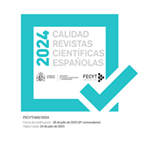Translating landscape in Der Archipelagus, by Friedrich Hölderlin
Abstract
The purpose of this article is the comparison of two different translations of the poem Der Archipelagus by Friedrich Hölderlin, focusing on the landscape elements which are essential for the construction of images in the poem. We start from the premise that the construction of a landscape necessarily reveals a view of the world and a way of inhabiting it, determined by the spirit of the poet's times, by the idiosyncrasy of his language and by his perception of the role of the human being in reality. We consider that a translation has to take all these elements into account, in order to offer in the target language a similar landscape in which to live as readers in the same way as we live in the landscape of the original poem. In the first place, we will proceed with an analysis of the landscape elements of the poem in the context of Hölderlin’s work and poetics and then we will approach the comparison, which we have articulated around the most relevant landscape movements and images of this poem.
Downloads
Article download
License
In order to support the global exchange of knowledge, the journal Estudios de Traducción is allowing unrestricted access to its content as from its publication in this electronic edition, and as such it is an open-access journal. The originals published in this journal are the property of the Complutense University of Madrid and any reproduction thereof in full or in part must cite the source. All content is distributed under a Creative Commons Attribution 4.0 use and distribution licence (CC BY 4.0). This circumstance must be expressly stated in these terms where necessary. You can view the summary and the complete legal text of the licence.









